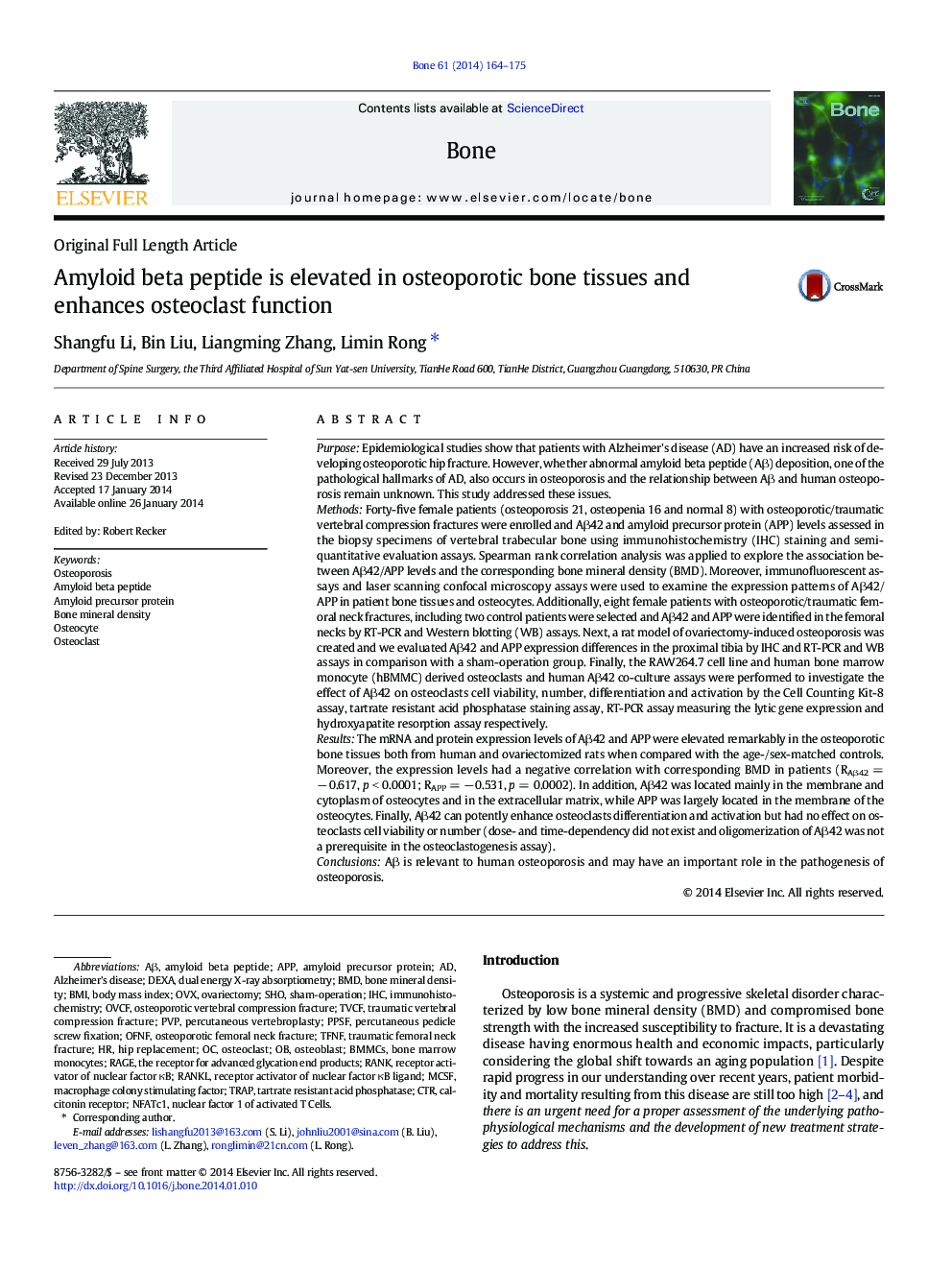| کد مقاله | کد نشریه | سال انتشار | مقاله انگلیسی | نسخه تمام متن |
|---|---|---|---|---|
| 5890271 | 1568158 | 2014 | 12 صفحه PDF | دانلود رایگان |
- Elevation of Aβ in osteoporotic bone tissues from patient and ovariectomized rat.
- Human Aβ42 had no effect on osteoclast cell viability and osteoclast numbers.
- Human Aβ42 potently enhanced osteoclast differentiation.
- Human Aβ42 potently enhanced osteoclast activation by about 2 fold increases.
- Aβ might have an important role in the pathogenesis of human osteoporosis.
PurposeEpidemiological studies show that patients with Alzheimer's disease (AD) have an increased risk of developing osteoporotic hip fracture. However, whether abnormal amyloid beta peptide (Aβ) deposition, one of the pathological hallmarks of AD, also occurs in osteoporosis and the relationship between Aβ and human osteoporosis remain unknown. This study addressed these issues.MethodsForty-five female patients (osteoporosis 21, osteopenia 16 and normal 8) with osteoporotic/traumatic vertebral compression fractures were enrolled and Aβ42 and amyloid precursor protein (APP) levels assessed in the biopsy specimens of vertebral trabecular bone using immunohistochemistry (IHC) staining and semi-quantitative evaluation assays. Spearman rank correlation analysis was applied to explore the association between Aβ42/APP levels and the corresponding bone mineral density (BMD). Moreover, immunofluorescent assays and laser scanning confocal microscopy assays were used to examine the expression patterns of Aβ42/APP in patient bone tissues and osteocytes. Additionally, eight female patients with osteoporotic/traumatic femoral neck fractures, including two control patients were selected and Aβ42 and APP were identified in the femoral necks by RT-PCR and Western blotting (WB) assays. Next, a rat model of ovariectomy-induced osteoporosis was created and we evaluated Aβ42 and APP expression differences in the proximal tibia by IHC and RT-PCR and WB assays in comparison with a sham-operation group. Finally, the RAW264.7 cell line and human bone marrow monocyte (hBMMC) derived osteoclasts and human Aβ42 co-culture assays were performed to investigate the effect of Aβ42 on osteoclasts cell viability, number, differentiation and activation by the Cell Counting Kit-8 assay, tartrate resistant acid phosphatase staining assay, RT-PCR assay measuring the lytic gene expression and hydroxyapatite resorption assay respectively.ResultsThe mRNA and protein expression levels of Aβ42 and APP were elevated remarkably in the osteoporotic bone tissues both from human and ovariectomized rats when compared with the age-/sex-matched controls. Moreover, the expression levels had a negative correlation with corresponding BMD in patients (RAβ42 = â 0.617, p < 0.0001; RAPP = â 0.531, p = 0.0002). In addition, Aβ42 was located mainly in the membrane and cytoplasm of osteocytes and in the extracellular matrix, while APP was largely located in the membrane of the osteocytes. Finally, Aβ42 can potently enhance osteoclasts differentiation and activation but had no effect on osteoclasts cell viability or number (dose- and time-dependency did not exist and oligomerization of Aβ42 was not a prerequisite in the osteoclastogenesis assay).ConclusionsAβ is relevant to human osteoporosis and may have an important role in the pathogenesis of osteoporosis.
Journal: Bone - Volume 61, April 2014, Pages 164-175
